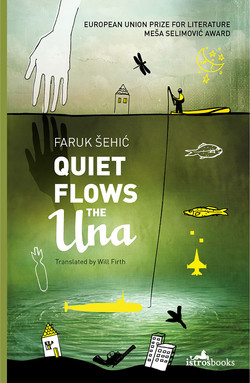Читать книгу Quiet Flows the Una - Faruk Šehić - Страница 12
На сайте Литреса книга снята с продажи.
ОглавлениеPrince of the Una, Dragons and Reconstruction
‘The leaves have fallen and now float dead and heavy down the Unadžik,’ I wrote with the terseness of a chronicler. I reread my words, observed the natural world and recorded the changing micro-structures of the river bank, the water and trees, when the roaring rainy backdrop of autumn gave way to the tranquillity of winter. Sometimes I headed off downstream from Grandmother Emina’s house for no particular reason, just to check how things were. First, I would stop at our greenhole and look till I found the grayling; further down, in the shallow water, trout would be waiting; then there came a cascade, below which was another greenhole, where there were troutlet; then there came a stretch with a sand-and-tufa bed, where chub kept watch at Mita’s house; further downstream the fish community was mixed; and just before the bridge young barbel with their golden bellies were in the majority, always clinging to the pebbles at the bottom. I was able to recognize and distinguish different fish by their traits. The appearance of a new fish in the aquatic realm of the Unadžik would heighten my passion of observation or, if you prefer, my obsession with fish, which required no logical explanation.
Wet and sodden leaves eventually sink to the bottom of the water like decomposed fish and become part of the river. The water loses its green-blue colour and turns icily transparent, heralding the long, cold winter. The whitefish withdraw from the Unadžik into deeper arms of the river, while trout, troutlet and grayling remain. Flies no longer fall on the surface, and the grayling now take only bread and the small crayfish from the bullrushes. The trout and troutlet patrol the water in search of small fry and become hungry and savage. Fishing for troutlet is prohibited during the winter and through until May. ‘Troutlet’ is our name for juvenile marble trout and they’re protected up to a length of 80 cm, although hardly anyone abides by the regulation. The troutlet is a long, fast silver-white fish with occasional black spots along its back and sides. Its belly is as white as snow and its tough head is somewhat darker. It’s one of the most voracious fish and attacks anything that moves in the water. Only the pike is more ravenous and has been known to snatch a full-grown duck, as well as feeding on frogs and goosanders – river birds that dive for small fish. Troutlet have a large white gullet, and in the late autumn and winter it’s easy to catch them with a nickel spoon lure or a female butterfly with a fluorescent sticker that shimmers enticingly when pulled through the water. True anglers consider it a sin to go after troutlet at that time because they’re blinded with hunger and attack every lure indiscriminately, but also particularly because troutlet are only a transitional stage in the development of the queen of the deep cascades, the Una marble trout, which can reach a weight of twenty-five kilograms. Several times I saw one of about ten kilograms, and I didn’t want to meet a really big one in the summer, eye to eye, when swimming in the deepest greenholes made by powerful, foaming cascades.
The troutlet is the prince of the Una and its hunting activity marks the beginning of winter, which sheathes the river banks in ice and snow. Then the river is more beautiful than ever because it’s decorated like a Christmas tree. The banks are coated with ice crystals of different shapes that cover the willow branches and bend them to the surface of the water. The water melts the ice during the day and the branches, whose bark has taken on a reddish, wintery colour, briefly come alive, but only till dusk, when the cold claps them in chains again. Once so much snow fell on the trees on the bank opposite my grandmother’s house that the bank looked like one long dune of snow. They say the Unadžik only completely froze over once, sometime in the 1930s, and that it then resembled a Siberian river – a team of horses was able to go along it with a sledge full of children. People also talked about the river dragons that lived long ago in the hidden caves that the rushing water had carved out of the tufa in the dark depths. The dragons disappeared many centuries ago when people gained mastery of the water. Or perhaps they’re still hiding in their caves and only rarely, at full moon and under cover of the Una’s unreal mists, do they fly out over the water and shower the river with gleaming scales. But enough of those empty stories.
